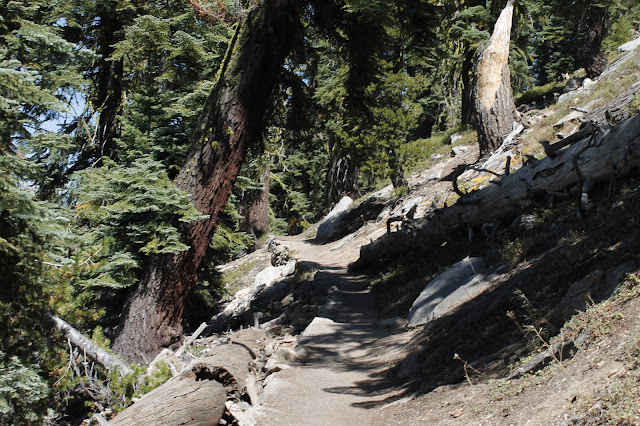This map was created using GPS Visualizer's do-it-yourself geographic utilities.
Please wait while the map data loads...
Date: 05/09/2016
From: Sentinel Dome Trailhead
Parking: Glacier Point Road
Start Point: Sentinel Dome Trailhead
Region: Yosemite National Park
Route length: 5.4 miles (8.7 km)
Time taken: 03:41
Average speed: 1.5 mph
Ascent: 341m
Descent: 357m
Summits: Sentinel Dome (2,476m)
Other points of interest: The Fissures, Taft Point
It's been a bit chaotic over the last few weeks as we moved All The Gear HQ from the Wakefield badlands to the leafy suburbs of Leeds. This culminated in an extended break on the other side of 'the pond' which means that most of August and early September have been walking write-offs. I do, however, have a special entry from our trip to the States which I thought would be worthy of a place in the archives of All The Gear But No Idea.
 |
| Jetting off to warmer climes |
 |
| Entering Yosemite National Park |
The National Parks of the US are managed slightly differently from those in the UK with permitting and preparation required to scale many of the mountains and an entrance fee necessary to access the park itself. Fortunately, there are trails (paths) aplenty and two of the more accessible ones both radiate from the Taft Point trailhead, one leading to Taft Point itself and one leading to Sentinel Dome. They can be joined using part of the Pohono Trail, which is exactly what we did.
 |
| Yosemite National Park is administered by the US National Park Service |
 |
| Entering the woods |
 |
| The trail passes through the fragrant woods |
 |
| Heading for Taft Point |
The Taft Point Trail reaches a junction with the Pohono Trail which is marked by metal marker boards. Taft Point stands a short half-mile further, still descending until the trees stop and the barren plateau opens up. Here you can find The Fissures, a series of cracks in the granite wall that offer a dizzying view down to Yosemite Valley, some 900m below. Up ahead is the overlook, Taft Point itself (also known as Profile Cliff).
 |
| The junction marker |
 |
| The trees begin the thin out |
 |
| One of the Taft Point fissures |
 |
| The overlook at Taft Point |
 |
| Approaching the overlook |
 |
| A look back along the rim |
 |
| The view from the Taft Point overlook |
 |
| El Capitan and the Merced River |
 |
| El Capitan and the Three Brothers |
 |
| The dry patch where Yosemite Falls usually is |
 |
| Cathedral Rocks and El Capitan |
 |
| Cathedral Rocks |
 |
| Sara at Taft Point |
 |
| The pine forest beckons |
 |
| Sentinel Dome peeks through the trees |
 |
| A reminder that you are in the high country |
A steady climb begins from the creek crossing which switchbacks its way up the lower slopes of Sentinel Dome, one of Yosemite's many rounded granite mountains. Ordinarily, this would be a straightforward climb up a relatively shallow gradient but the effects of the elevation made it a little tougher than it first appeared.
 |
| The trail climbs up around Sentinel Dome |
 |
| A metal sign marks the final climb |
 |
| Climbing Sentinel Dome |
 |
| Half Dome and the Sierra Nevada |
 |
| Half Dome with Clouds Rest behind |
 |
| Cathedral Rocks and El Capitan |
 |
| Mount Starr King with Clark Range beyond |
 |
| Sara enjoying the grandeur of Half Dome |
 |
| View towards the Clark Range along the Illouette valley |
 |
| Sentinel Dome |
 |
| Descending back through the pine trees |
 |
| One last view of Sentinel Dome |
 |
| Valley View - El Capitan and Cathedral Rocks over the Merced River |
 |
| Tenaya Lake |
 |
| The famous Tunnel View |
 |
| Half Dome and Clouds Rest |
 |
| The awe-inspiring Glacier Point |

No comments :
Post a Comment